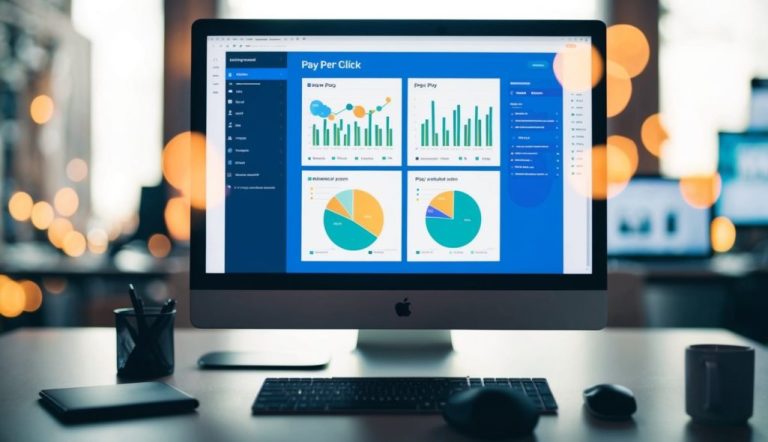Understanding pay-per-click (PPC) marketing can feel overwhelming, but a solid plan can lead you to success. Setting clear goals and choosing the right keywords is the key to an effective PPC campaign. By doing this, you ensure that your ads reach the audience most likely to engage with your content.

Crafting engaging ad copy and optimizing landing pages are crucial steps that should not be overlooked. These elements can drive better conversions, as they directly impact how potential customers perceive your offerings.
Leveraging data to refine and improve your campaigns continuously can lead to better results and more efficient budget management.
Key Takeaways
- Set clear goals and choose the right keywords.
- Craft engaging ad copy and optimize landing pages.
- Utilize data for ongoing campaign improvement.
Understanding PPC Fundamentals
In the world of digital marketing, PPC advertising is a key strategy. It involves pay-per-click platforms like Google Ads and social media networks, which play a crucial role in targeting audiences through search engines and engaging with potential customers effectively.
Defining PPC and Its Importance in Digital Marketing
PPC, or Pay-Per-Click, is a model of online advertising where you pay a fee each time someone clicks on your ad. Instead of earning visits organically, you’re essentially buying visits to your site.
This method is vital in digital marketing as it can quickly drive traffic and improve your reach. By targeting specific demographics based on interests, location, or behavior, you can maximize your advertising budget.
Using PPC, you can also measure your return on investment (ROI) effectively. Tools provided by PPC platforms offer data analysis, enabling you to adjust strategies in real-time.
The Role of Search Engines in PPC Advertising
Search engines are central to PPC advertising. Platforms like Google and Bing offer prime real estate for ads, placing them at the top of relevant search results. This is known as search engine marketing (SEM), where advertisers bid on keywords.
By effectively using bidding strategies, your ads appear for relevant queries. It increases visibility where it matters most, driving clicks from users actively seeking information or products like yours.
Search engines provide tools to target specific audiences through factors like geography and device type. Understanding this role helps optimize your campaigns for better performance.
PPC Platforms: From Google Ads to Social Media
While Google Ads is a major player in PPC, other platforms like Facebook Ads, Microsoft Ads, LinkedIn Ads, and Amazon Ads also offer valuable opportunities. Each has unique strengths, catering to different types of audiences and advertising goals.
For example, Facebook Ads is ideal for targeting users based on detailed demographic and interest data. Meanwhile, LinkedIn Ads is preferred for B2B marketing, focusing on professional networks.
Using multiple PPC platforms allows you to diversify your strategies. Testing different approaches helps identify where you best reach your target audience and achieve your marketing objectives.
Crafting Your PPC Marketing Strategy
In creating a successful PPC marketing strategy, you must first understand your audience and what they want. By setting clear goals for both ROI and ROAS, and ensuring your PPC strategies align with your broader business objectives, you can optimize your campaigns for success.
Identifying the Target Audience and Their Needs
Your target audience is key to any PPC marketing effort. Understanding their needs starts with segmenting them based on various factors like demographics, interests, and online behavior. Tools like Google Analytics provide deep insights into audience behavior.
Once segmented, craft tailored messages that directly speak to these needs. This means using marketing data to highlight problems your products or services solve. Testing ad variations can reveal what resonates most, ensuring messages remain relevant. This focus aids in higher engagement rates and better conversion.
Setting Clear Goals for ROI and ROAS
Establishing clear goals helps measure how effectively your PPC ads are generating returns. ROI and ROAS are key metrics for evaluating profitability. ROI measures the gain from your marketing spend, while ROAS helps understand revenue generated per dollar spent on advertising.
To set these goals, consider your business’s cost structure and desired profit margins. By analyzing past performance data, you can pinpoint effective strategies. This enables adjustments that enhance profitability. Continuous monitoring ensures your campaign remains aligned with financial objectives, maximizing your marketing investment.
Aligning PPC with Overall Business Objectives
Aligning PPC strategies with business objectives ensures cohesive growth. Start by detailing your goals, whether it’s increasing brand awareness, driving sales, or enhancing customer engagement. Understanding how PPC fits into these broader aims is crucial.
Next, select PPC platforms that complement your goals. For instance, Google Ads or Facebook Ads offer distinct benefits depending on your target demographic. Regularly update strategies to reflect changes in business direction or market conditions. This alignment not only optimizes ad performance but also enhances your overall marketing strategy.
Keyword Research and Selection
Selecting the right keywords is essential for a successful PPC campaign. This section will guide you through the importance of using the right keywords and how to make smart choices with long-tail and negative keywords.
The Significance of Keywords in PPC Campaigns
Keywords are the foundation of any PPC campaign. They define when your ads appear in front of a potential customer. Choosing the right keywords ensures your ads reach the right audience.
Start by aligning keywords with your campaign goals and your target audience’s search intent. Using tools like Google’s Keyword Planner helps you find relevant keywords and understand their search volume and competition. Balancing these aspects is crucial to maximizing your ad performance and return on investment.
Utilizing Long-Tail Keywords for Better Targeting
Long-tail keywords are phrases with three or more words that are highly specific. While they have lower search volumes, they often lead to higher conversion rates because they match specific search queries. This means less competition and more precise targeting.
Adding long-tail keywords to your ad groups can help attract niche markets and improve the effectiveness of your ads. For example, using “best running shoes for flat feet” targets a specific need, which can lead to more conversions and less wasted ad spend.
Employing Negative Keywords to Refine Traffic
Negative keywords prevent your ads from showing in undesirable searches, saving your budget and improving ad relevance. They help filter out traffic that’s unlikely to convert.
For instance, if you sell luxury watches, adding “cheap” as a negative keyword stops your ad from showing in searches for “cheap watches.” Regularly review and update your list of negative keywords to refine who sees your ads, focus your budget, and enhance the quality of your traffic. This approach reduces irrelevant clicks and increases the efficiency of your PPC campaigns.
Creating Effective Ad Copy
To create effective ad copy, focus on crafting compelling headlines and descriptions, improving ad relevance with quality scores in mind, and utilizing responsive search ads. These elements help in attracting clicks and boosting ad performance.
Writing Compelling Headlines and Descriptions
Creating strong headlines and descriptions is key to capturing attention. Your headline should be clear and informative, quickly conveying the value of your offer. Use action words that encourage engagement. For example, words like “discover,” “save,” or “learn” can make a difference.
The description should expand on the headline, offering more detail about the benefits of your product or service. Maintain clarity and avoid jargon. Use bullet points where possible to enhance readability. Highlight unique selling points to persuade users to click.
Enhancing Ad Relevance with Quality Score in Mind
Quality score plays a significant role in ad performance, impacting both cost and placement. To optimize it, ensure that the ad copy, keywords, and landing page content are tightly aligned.
Use keywords naturally within your ad copy to boost relevance without overstuffing.
Monitoring the click-through rate (CTR) is also essential. A higher CTR indicates that users find your ad relevant and engaging. Ensure your landing page provides a seamless and useful experience matching the advertisement promise, which improves user satisfaction and quality score.
Responsive Search Ads and Their Impact on Performance
Responsive search ads allow you to test multiple headlines and descriptions. Google’s algorithm then determines the best combinations to optimize performance.
This format can increase your reach and improve ad effectiveness by automatically adjusting to users’ behavior.
To make the most of responsive search ads, provide a variety of headlines and descriptions. Ensure each one focuses on different aspects of your offer. Monitor which combinations perform well, and iterate based on data. This flexibility helps in continuously refining your ad strategy for the best outcomes.
Optimizing Landing Pages for Conversion
To increase conversions, your landing page must be designed with user experience in mind. Consistent A/B testing helps in refining these elements. Moreover, loading speed significantly affects conversion rates.
Importance of Design and User Experience
A well-designed landing page can greatly improve your conversion rate. Focus on a clean layout that guides users to the desired action. Elements like strong headlines and images should be used to catch attention. Your page should have a logical structure, making it easy for visitors to understand what you offer.
User experience is key. This means that your landing page should be easy to navigate. Clear calls-to-action (CTAs) direct users toward conversion goals. Consistency between your ad and the landing page content helps maintain user trust. Further, ensure it’s mobile-friendly to reach a wider audience.
A/B Testing and Continuous Improvement
Engaging in A/B testing is essential for identifying what works best on your landing page. By creating different versions of your page, you can test variables like headlines, images, or CTAs. This helps you find the combination that leads to the most conversions. Implement improvements based on clear data.
Continuous improvement doesn’t stop with one round of testing. Regularly update your landing page as audience preferences change. Analyze the test results to hone in on the features that drive the highest conversion rates. This ongoing process helps keep your landing page effective over time. Learn more on PPC optimization best practices.
The Impact of Loading Speed on Conversions
Loading speed plays a crucial role in conversion rates. If your landing page takes too long to load, users are likely to leave before it fully appears. This bounce leads to lost conversions.
Aim to keep the page loading time under three seconds for the best results.
Invest in tools and practices to improve loading speed. Optimize images and minimize redirects to boost performance. Fast-loading pages keep users engaged, which can lead to higher conversion rates. Make sure to test your page’s loading speed regularly to ensure it meets user expectations, as each second counts.
Campaign Structure and Targeting Options
When structuring your PPC campaigns, focusing on single keyword strategies, targeting options, and ad placement can enhance your performance. These aspects help ensure your ads reach the right audience, maintain high visibility, and achieve desired results.
Single Keyword Ad Groups and Their Efficacy
Single Keyword Ad Groups (SKAGs) have gained popularity for their precision. By focusing each ad group on one keyword, you can tailor your ads to match search terms closely. This increases the relevance of your ads, potentially boosting click-through rates.
SKAGs also make it easier to manage keywords, refine messaging, and improve Quality Scores. This targeted approach allows you to control bids and budgets more effectively, ensuring that your resources are allocated to high-performing keywords. However, it’s crucial to monitor and adjust these groups regularly to maintain efficiency.
Choosing the Right Targeting Options for Your Audience
Selecting the appropriate targeting options is essential for reaching the right audience. You can use different criteria such as demographics, location, and device preference.
For example, demographic targeting helps you reach specific age groups, while location targeting ensures your ads are seen by users in defined areas.
Device targeting allows you to optimize your campaigns for mobile, desktop, or tablet users based on their behavior and interaction. Using negative keywords is also crucial to avoid showing ads to irrelevant search terms, improving your return on investment.
Consistently refining your targeting options helps align your campaigns with market changes and audience needs.
Ad Placement and Ad Rank Considerations
Your ad’s placement significantly impacts its visibility and performance. High ad placement usually results in more clicks, but achieving this requires a good Ad Rank. Ad Rank is influenced by bid amount, ad quality, and expected impact from ad extensions.
Improving your ad quality through relevant content and strong CTAs can enhance your Ad Rank. Utilizing ad extensions, like sitelinks and callouts, can also boost engagement.
It’s important to find a balance between bidding high enough for good placement without overspending on low-converting terms. Regularly evaluating these strategies will ensure optimal placement and performance.
By understanding these components, you can craft PPC campaigns that effectively engage your audience and achieve your advertising goals.
Budget Management and Cost Control
Managing your advertising budget effectively in pay-per-click (PPC) campaigns is crucial for maximizing return on investment.
By understanding your cost per click (CPC) and adjusting bids strategically, you can ensure cost-effective spending while enhancing ad visibility.
Determining the Optimal Advertising Budget
To set the right advertising budget, you need to analyze your campaign goals. Start by identifying your targets, like the number of clicks or conversions you want to achieve.
Calculate the budget based on your desired outcomes. For instance, determine how much you can afford to spend on each click knowing it will directly affect your overall budget.
Use simple formulas to estimate costs. For example, if you want 50 clicks daily and your average CPC is $2, your monthly budget should be around $3,000.
Adjust your calculations based on your specific goals and resources. Regularly review and update your budget to meet changing needs and market conditions.
Managing Bids for Cost-Effective Ad Spend
Bid management is key to controlling costs in PPC advertising. Evaluate your maximum bid settings carefully.
Set realistic bids that align with your overall budget while ensuring sufficient reach and visibility. Regular monitoring and adjusting bids based on performance can significantly boost cost efficiency.
Utilize bidding strategies available on platforms like Google Ads. These include automated strategies that adjust bids based on goals, such as maximizing conversions.
Another method is manual bidding, which gives you direct control over individual bid amounts. Balancing these approaches can optimize your ad spend.
Cost Per Click and Maximizing Ad Visibility
Cost per click (CPC) is a major factor in PPC campaigns. It defines how much you pay each time someone clicks your ad.
Lowering your CPC while maintaining or improving visibility is essential.
Focus on quality score improvements, which can lower your CPC by increasing ad relevance.
Ensure your ad content aligns with target keywords and create effective landing pages. These not only boost your quality score but also improve user experience.
Analyze keyword performance regularly to adjust and eliminate non-performing keywords, ensuring you’re getting the most value from your ad spend.
Analyzing and Leveraging Data
To make the most of your PPC campaigns, it’s important to focus on analyzing and leveraging key data. This includes using tools to measure success, applying conversion data, and understanding critical metrics like CTR and CPC. These steps help in fine-tuning campaign strategies for better performance.
Measuring Success with Google Analytics and Other Tools
You can track how well your PPC campaigns are doing with tools like Google Analytics. These tools offer insights into user behavior, how long visitors stay on your site, and which pages they view.
Setting up goals within Google Analytics helps measure your conversion rate, giving you clear indicators of PPC success.
Tools like Google Ads and SEMrush can also provide additional data for detailed analysis.
By analyzing this data, you can adjust your marketing strategies. This means focusing on what works well and improving areas that don’t perform as expected. Regularly reviewing your analytics data ensures your campaigns stay effective.
Using Conversion Data to Refine PPC Campaigns
Conversion data gives you valuable information about what actions users take after clicking your ads. This helps you understand which keywords and ads are most effective.
By refining your use of keywords and ad copy, you can increase your conversion rate. It’s also useful to experiment with different call-to-action phrases and landing pages.
Analyzing conversion data can show trends over time, signaling what changes might improve performance. This ongoing refinement is key to ensuring your PPC campaigns remain competitive and deliver a good return on investment.
Learning from PPC Metrics: CTR, CPC, and More
Understanding metrics like click-through rate (CTR) and cost per click (CPC) is vital. These metrics show how well your ads attract clicks and how much you’re paying for each.
A high CTR means your ads are relevant and engaging, while a low CPC can improve your campaign’s profitability.
Other metrics to monitor include bounce rate and session duration. These give insights into user engagement after they’ve clicked on your ad. Keeping track of these data points allows you to make informed decisions on where to allocate your marketing budget effectively.
Advanced PPC Techniques
Advanced techniques in PPC can enhance your ad campaigns by focusing on remarketing strategies, embracing automation, and integrating with e-commerce. These practices help increase engagement, boost efficiency, and align with broader business strategies.
Remarketing and Retargeting for Increased Engagement
Remarketing and retargeting are essential for keeping your brand in front of potential customers. By targeting users who have previously interacted with your site, you can increase engagement and conversions.
Tools such as Google Ads allow you to set up custom audiences based on visitor behavior. Segment your audience to show them tailored ads that resonate with their past interactions. This makes it easier to convert warm leads into customers.
Use display ads to remind users of products they’ve viewed and encourage them to complete their purchases.
Utilizing PPC Automation for Efficiency
PPC automation helps you manage your campaigns more efficiently by using machine learning to optimize bids and placements.
This can save time and money by automatically adjusting bids based on performance data.
Automation tools can help with keyword bidding, ad copy adjustments, and even pause underperforming ads.
Using platforms like Google Ads’ automated bidding strategies can improve your paid search effectiveness. By setting clear goals, you can let the system work toward achieving those targets, freeing you to focus on strategy.
Integration with Ecommerce and Retail Strategies
Integrating PPC with your e-commerce strategy can boost your sales and visibility. By aligning your PPC campaigns with your retail initiatives, such as promotions or new product launches, you can improve overall performance.
Use data from your e-commerce platform to inform your paid search tactics. It’s important to optimize your landing pages so users can easily complete purchases.
Making sure your product information is accurate and up-to-date helps in driving successful PPC campaigns. Additionally, consider using Google Shopping ads to directly promote your products to online shoppers, maximizing your reach and conversions.
Frequently Asked Questions
Understanding PPC campaigns can help you achieve better results. This section covers key points like optimizing performance, strategies, metrics, ad copy, testing, and targeting.
How can you optimize a PPC campaign for better performance?
To optimize a PPC campaign, focus on improving ad targeting and adjusting bids based on performance.
Use negative keywords to avoid irrelevant traffic, and refine your ad copy and landing pages to boost conversions.
Regularly review and adjust your strategy to improve your results.
What are the key considerations when creating a PPC strategy?
When creating a PPC strategy, consider your budget, target audience, and advertising goals.
Determine the keywords that align with your business objectives and decide on the platforms where you want to run your ads.
It helps to have a clear understanding of the competitive landscape to set realistic objectives.
What metrics should you focus on to measure the success of a PPC campaign?
Important metrics include Click-Through Rate (CTR), Cost-Per-Click (CPC), conversion rate, and Return on Ad Spend (ROAS).
These metrics give insights into how well your ads are performing in attracting and converting visitors into customers. Monitoring these will help in making informed decisions about needed adjustments.
Which practices are recommended for writing effective PPC ad copy?
Effective PPC ad copy is clear, concise, and relevant to the audience.
Use strong call-to-action phrases and highlight unique selling points.
Ensure that the ad aligns with the keywords and includes a sense of urgency or special offer to encourage clicks.
How often should you perform A/B testing on your PPC ads?
A/B testing should be done regularly, but the exact frequency depends on your campaign size and goals.
Test new ad elements whenever you observe a decline in performance or when launching a new campaign.
Continuous testing helps refine your approach and improve your ad effectiveness over time.
What role does audience targeting play in the success of PPC advertising?
Audience targeting is crucial. It ensures your ads reach the right people who are more likely to be interested in your products or services.
By focusing on demographics, interests, and behaviors, you can improve the relevance of your ads and increase the likelihood of achieving your campaign objectives.





